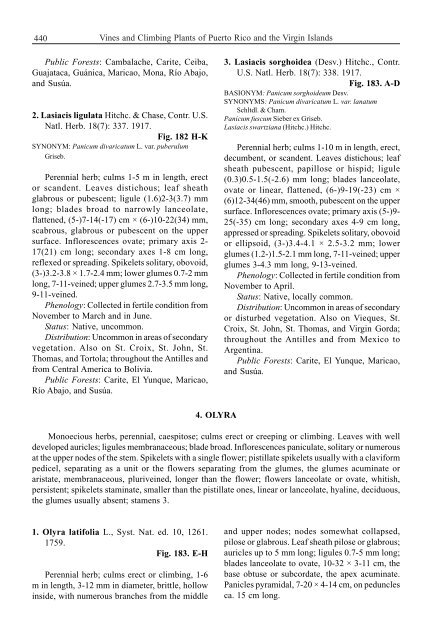Vines and Climbing Plants of Puerto Rico and the Virgin Islands
Vines and Climbing Plants of Puerto Rico and the Virgin Islands
Vines and Climbing Plants of Puerto Rico and the Virgin Islands
You also want an ePaper? Increase the reach of your titles
YUMPU automatically turns print PDFs into web optimized ePapers that Google loves.
440<br />
<strong>Vines</strong> <strong>and</strong> <strong>Climbing</strong> <strong>Plants</strong> <strong>of</strong> <strong>Puerto</strong> <strong>Rico</strong> <strong>and</strong> <strong>the</strong> <strong>Virgin</strong> Isl<strong>and</strong>s<br />
Public Forests: Cambalache, Carite, Ceiba,<br />
Guajataca, Guánica, Maricao, Mona, Río Abajo,<br />
<strong>and</strong> Susúa.<br />
2. Lasiacis ligulata Hitchc. & Chase, Contr. U.S.<br />
Natl. Herb. 18(7): 337. 1917.<br />
Fig. 182 H-K<br />
SYNONYM: Panicum divaricatum L. var. puberulum<br />
Griseb.<br />
Perennial herb; culms 1-5 m in length, erect<br />
or sc<strong>and</strong>ent. Leaves distichous; leaf sheath<br />
glabrous or pubescent; ligule (1.6)2-3(3.7) mm<br />
long; blades broad to narrowly lanceolate,<br />
flattened, (5-)7-14(-17) cm × (6-)10-22(34) mm,<br />
scabrous, glabrous or pubescent on <strong>the</strong> upper<br />
surface. Inflorescences ovate; primary axis 2-<br />
17(21) cm long; secondary axes 1-8 cm long,<br />
reflexed or spreading. Spikelets solitary, obovoid,<br />
(3-)3.2-3.8 × 1.7-2.4 mm; lower glumes 0.7-2 mm<br />
long, 7-11-veined; upper glumes 2.7-3.5 mm long,<br />
9-11-veined.<br />
Phenology: Collected in fertile condition from<br />
November to March <strong>and</strong> in June.<br />
Status: Native, uncommon.<br />
Distribution: Uncommon in areas <strong>of</strong> secondary<br />
vegetation. Also on St. Croix, St. John, St.<br />
Thomas, <strong>and</strong> Tortola; throughout <strong>the</strong> Antilles <strong>and</strong><br />
from Central America to Bolivia.<br />
Public Forests: Carite, El Yunque, Maricao,<br />
Río Abajo, <strong>and</strong> Susúa.<br />
4. OLYRA<br />
3. Lasiacis sorghoidea (Desv.) Hitchc., Contr.<br />
U.S. Natl. Herb. 18(7): 338. 1917.<br />
Fig. 183. A-D<br />
BASIONYM: Panicum sorghoideum Desv.<br />
SYNONYMS: Panicum divaricatum L. var. lanatum<br />
Schltdl. & Cham.<br />
Panicum fuscum Sieber ex Griseb.<br />
Lasiacis swartziana (Hitchc.) Hitchc.<br />
Perennial herb; culms 1-10 m in length, erect,<br />
decumbent, or sc<strong>and</strong>ent. Leaves distichous; leaf<br />
sheath pubescent, papillose or hispid; ligule<br />
(0.3)0.5-1.5(-2.6) mm long; blades lanceolate,<br />
ovate or linear, flattened, (6-)9-19(-23) cm ×<br />
(6)12-34(46) mm, smooth, pubescent on <strong>the</strong> upper<br />
surface. Inflorescences ovate; primary axis (5-)9-<br />
25(-35) cm long; secondary axes 4-9 cm long,<br />
appressed or spreading. Spikelets solitary, obovoid<br />
or ellipsoid, (3-)3.4-4.1 × 2.5-3.2 mm; lower<br />
glumes (1.2-)1.5-2.1 mm long, 7-11-veined; upper<br />
glumes 3-4.3 mm long, 9-13-veined.<br />
Phenology: Collected in fertile condition from<br />
November to April.<br />
Status: Native, locally common.<br />
Distribution: Uncommon in areas <strong>of</strong> secondary<br />
or disturbed vegetation. Also on Vieques, St.<br />
Croix, St. John, St. Thomas, <strong>and</strong> <strong>Virgin</strong> Gorda;<br />
throughout <strong>the</strong> Antilles <strong>and</strong> from Mexico to<br />
Argentina.<br />
Public Forests: Carite, El Yunque, Maricao,<br />
<strong>and</strong> Susúa.<br />
Monoecious herbs, perennial, caespitose; culms erect or creeping or climbing. Leaves with well<br />
developed auricles; ligules membranaceous; blade broad. Inflorescences paniculate, solitary or numerous<br />
at <strong>the</strong> upper nodes <strong>of</strong> <strong>the</strong> stem. Spikelets with a single flower; pistillate spikelets usually with a claviform<br />
pedicel, separating as a unit or <strong>the</strong> flowers separating from <strong>the</strong> glumes, <strong>the</strong> glumes acuminate or<br />
aristate, membranaceous, pluriveined, longer than <strong>the</strong> flower; flowers lanceolate or ovate, whitish,<br />
persistent; spikelets staminate, smaller than <strong>the</strong> pistillate ones, linear or lanceolate, hyaline, deciduous,<br />
<strong>the</strong> glumes usually absent; stamens 3.<br />
1. Olyra latifolia L., Syst. Nat. ed. 10, 1261.<br />
1759.<br />
Fig. 183. E-H<br />
Perennial herb; culms erect or climbing, 1-6<br />
m in length, 3-12 mm in diameter, brittle, hollow<br />
inside, with numerous branches from <strong>the</strong> middle<br />
<strong>and</strong> upper nodes; nodes somewhat collapsed,<br />
pilose or glabrous. Leaf sheath pilose or glabrous;<br />
auricles up to 5 mm long; ligules 0.7-5 mm long;<br />
blades lanceolate to ovate, 10-32 × 3-11 cm, <strong>the</strong><br />
base obtuse or subcordate, <strong>the</strong> apex acuminate.<br />
Panicles pyramidal, 7-20 × 4-14 cm, on peduncles<br />
ca. 15 cm long.
















